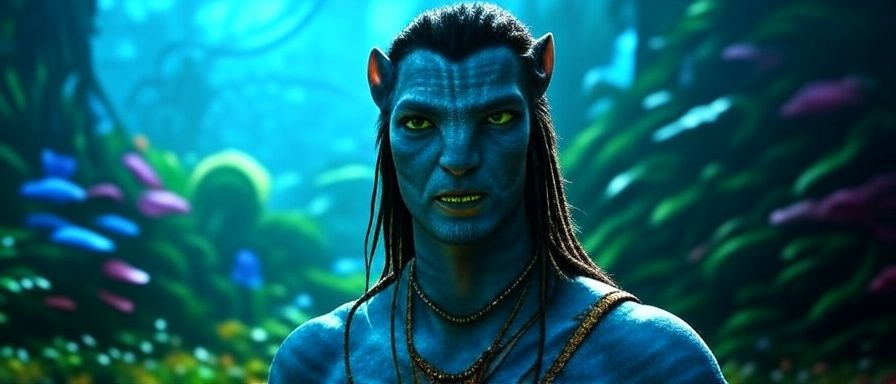In 2009, Avatar, directed by James Cameron, burst onto the global stage, redefining what a blockbuster film could be. With its breathtaking visuals, groundbreaking technology, and compelling narrative, Avatar not only shattered box office records but also left an indelible mark on the film industry and popular culture. This blog article dives deep into the Avatar phenomenon, exploring its creation, themes, technological innovations, cultural impact, and lasting legacy. Written for all audiences, this case study aims to unpack the magic of Avatar in a simple, engaging, and comprehensive way.

𝗧𝗵𝗲 𝗚𝗲𝗻𝗲𝘀𝗶𝘀 𝗼𝗳 𝗔𝘃𝗮𝘁𝗮𝗿: 𝗔 𝗩𝗶𝘀𝗶𝗼𝗻 𝗬𝗲𝗮𝗿𝘀 𝗶𝗻 𝘁𝗵𝗲 𝗠𝗮𝗸𝗶𝗻𝗴
Avatar is set in the mid-22nd century on Pandora, a lush, alien moon inhabited by the Na’vi, a humanoid species deeply connected to their environment. The story follows Jake Sully, a paraplegic ex-Marine who joins a corporate-run mission to mine a valuable mineral called “unobtanium.” Humans use “avatars”—genetically engineered Na’vi bodies controlled by human consciousness—to interact with Pandora’s toxic atmosphere and its native inhabitants. Jake’s journey from a reluctant spy to a defender of the Na’vi forms the heart of the film.
James Cameron, the visionary behind Titanic and The Terminator, first conceived Avatar in the mid-1990s. However, the technology to bring his ambitious vision to life didn’t exist at the time. Cameron waited over a decade, refining his ideas and pushing for advancements in filmmaking technology. By 2006, he began writing the screenplay, and production kicked off in 2007. The result was a film that blended live-action, computer-generated imagery (CGI), and groundbreaking 3D technology to create an immersive experience unlike anything audiences had seen before.
The film’s budget was staggering—estimated at $237 million for production, with marketing costs pushing the total closer to $500 million. Despite the financial risk, Avatar became the highest-grossing film of all time, earning over $2.7 billion globally. Its success was a testament to Cameron’s bold vision and the universal appeal of its story.
𝗧𝗵𝗲 𝗦𝘁𝗼𝗿𝘆 𝗮𝗻𝗱 𝗖𝗵𝗮𝗿𝗮𝗰𝘁𝗲𝗿𝘀: 𝗔 𝗨𝗻𝗶𝘃𝗲𝗿𝘀𝗮𝗹 𝗧𝗮𝗹𝗲

At its core, Avatar is a story about connection, morality, and the clash between greed and harmony. Jake Sully (Sam Worthington), a former Marine confined to a wheelchair, is recruited to replace his deceased twin brother in the Avatar Program. His mission is to infiltrate the Na’vi and gather intelligence for the Resources Development Administration (RDA), a corporation intent on mining unobtanium, even if it means destroying the Na’vi’s sacred Hometree.
Jake’s journey takes a transformative turn when he meets Neytiri (Zoe Saldaña), a Na’vi warrior who teaches him the ways of her people. Through Neytiri, Jake discovers the Na’vi’s deep spiritual connection to Pandora’s ecosystem, particularly through the Tree of Souls, a sacred site that links all life on the planet. As Jake becomes part of the Na’vi community, he faces a moral dilemma: follow orders to betray the Na’vi or fight to protect their way of life.
The film’s supporting characters add depth to the narrative. Dr. Grace Augustine (Sigourney Weaver) is a scientist advocating for peaceful coexistence with the Na’vi. Colonel Miles Quaritch (Stephen Lang) represents the militaristic, profit-driven mindset of the RDA. Other key figures include Neytiri’s parents, Mo’at (CCH Pounder) and Eytukan (Wes Studi), and Tsu’tey (Laz Alonso), a proud Na’vi warrior.
Critics noted similarities between Avatar’s plot and films like Dances with Wolves and Pocahontas, with some calling it a “white savior” narrative. While the story follows familiar archetypes, its emotional resonance and universal themes—environmentalism, anti-imperialism, and the search for belonging—struck a chord with audiences worldwide.
𝗧𝗲𝗰𝗵𝗻𝗼𝗹𝗼𝗴𝗶𝗰𝗮𝗹 𝗜𝗻𝗻𝗼𝘃𝗮𝘁𝗶𝗼𝗻: 𝗥𝗲𝗱𝗲𝗳𝗶𝗻𝗶𝗻𝗴 𝗙𝗶𝗹𝗺𝗺𝗮𝗸𝗶𝗻𝗴

Avatar’s most celebrated achievement is its technological innovation. Cameron and his team pushed the boundaries of filmmaking, creating a fully realized world that felt tangible and alive. Here are the key technological advancements that made Avatar a game-changer:
• 3D Technology and the Fusion Camera System
Unlike traditional 3D films, which often caused eye strain due to flickering images, Avatar used the Fusion Camera System, developed by Cameron and cinematographer Vince Pace. This system employed lightweight, high-definition cameras to capture two images simultaneously, mimicking human vision for a seamless 3D experience. By projecting 144 images per second, the system eliminated issues like ghosting and judder, delivering crisp, immersive visuals.
Motion Capture and Performance Capture
Approximately 70% of Avatar’s footage is CGI, with actors performing in motion-capture suits covered in sensors. These suits recorded body movements, while a skull cap with a tiny camera captured facial expressions in real time. This “performance capture” technique allowed animators to translate actors’ performances into their Na’vi counterparts with unprecedented realism. Cameron’s use of a virtual camera—a handheld monitor that let him navigate the 3D world in real time—further revolutionized the directing process.
World-Building with CGI
Pandora’s lush landscapes, bioluminescent flora, and exotic creatures were brought to life through meticulous CGI. The film’s production involved collaboration with Weta Digital, the visual effects company behind The Lord of the Rings. A massive server farm, spanning 10,000 square feet and powered by 4,000 HP servers, stored the enormous data required—each minute of the film consumed 17.28 gigabytes. The result was a visually stunning world that felt both alien and believable.
The Na’vi Language
To enhance authenticity, Cameron enlisted linguist Paul Frommer to create the Na’vi language, complete with over 1,000 words and unique phonemes. This attention to detail extended to the film’s biology, with set designers consulting plant physiologists to craft Pandora’s ecosystem.
These innovations didn’t just enhance Avatar’s storytelling—they set a new standard for the film industry, inspiring a wave of 3D films and advancing motion-capture technology for future projects.
𝗧𝗵𝗲𝗺𝗲𝘀 𝗮𝗻𝗱 𝗦𝘆𝗺𝗯𝗼𝗹𝗶𝘀𝗺: 𝗔 𝗠𝗲𝘀𝘀𝗮𝗴𝗲 𝗳𝗼𝗿 𝗢𝘂𝗿 𝗧𝗶𝗺𝗲

Avatar is more than a visual spectacle; it’s a film with a powerful message. Its themes resonate across cultures and generations, making it a universal story. Here are the key themes explored in the film:
Environmentalism
Pandora is a vibrant, interconnected ecosystem, with the Na’vi living in harmony with nature. The film critiques humanity’s exploitation of natural resources, drawing parallels to real-world issues like deforestation and climate change. The destruction of Hometree mirrors the devastation of Earth’s forests, while the Na’vi’s reverence for the Tree of Souls underscores the importance of preserving biodiversity. Cameron himself has described Avatar as a call to action, urging audiences to reconsider humanity’s impact on the planet.
Anti-Imperialism and Colonialism
The conflict between the RDA and the Na’vi reflects historical patterns of colonialism, where powerful entities exploit indigenous populations for profit. Critics have drawn comparisons to the colonization of the Americas and modern conflicts over resources. Jake’s decision to side with the Na’vi challenges the notion of blind loyalty to authority and highlights the moral cost of imperialism.
Spirituality and Connection
The Na’vi’s spiritual bond with Pandora, facilitated by neural connections between living beings, emphasizes unity and interdependence. The Tree of Souls allows the Na’vi to commune with their ancestors, reinforcing the idea that all life is interconnected. Some viewers saw parallels to indigenous belief systems, while others noted influences from Hinduism, particularly in the film’s title and the Na’vi’s blue skin, reminiscent of deities like Krishna.
Moral Choices and Redemption
Jake’s transformation from a corporate pawn to a Na’vi ally is a journey of redemption. His decision to defy orders and protect the Na’vi showcases the power of individual agency in the face of systemic injustice. Other characters, like Dr. Grace Augustine and pilot Trudy Chacón (Michelle Rodriguez), also make courageous choices, reinforcing the film’s message of standing up for what’s right.
While some critics dismissed Avatar’s story as clichéd, its straightforward narrative allowed its themes to shine through, making it accessible to a broad audience.
𝗖𝘂𝗹𝘁𝘂𝗿𝗮𝗹 𝗜𝗺𝗽𝗮𝗰𝘁: 𝗧𝗵𝗲 𝗣𝗮𝗻𝗱𝗼𝗿𝗮 𝗘𝗳𝗳𝗲𝗰𝘁

Avatar’s release was a cultural event, sparking discussions and inspiring real-world movements. Its impact extended beyond the screen in several ways:
Box Office and Awards
Avatar grossed over $2.7 billion, making it the highest-grossing film until Avengers: Endgame surpassed it in 2019. It was nominated for nine Academy Awards, winning three for Best Art Direction, Best Cinematography, and Best Visual Effects. Critics praised its technical achievements, though some felt its narrative didn’t match its visual brilliance.
The Pandora Effect
The film’s vivid depiction of Pandora led to a phenomenon dubbed the “Pandora Effect,” where viewers reported feelings of depression or longing for a world like Pandora. This emotional response highlighted the film’s ability to tap into a universal desire for connection with nature and a simpler, more harmonious way of life. Social media groups and even a dedicated “Avatar Day” on April 22, 2010, emerged to promote environmental awareness inspired by the film.
Controversies and Criticisms
Avatar faced criticism for its “white savior” trope, with some arguing that Jake’s role as the Na’vi’s leader perpetuated stereotypes about indigenous peoples needing external salvation. Others saw the film as a critique of American imperialism, with references to “shock and awe” and military tactics evoking the Iraq War. Cameron defended the film, arguing it was not anti-American but a call for moral responsibility.
Inspiration for Filmmakers
The film’s success spurred a 3D boom in Hollywood, with studios rushing to convert films to the format. While some, like Monsters vs. Aliens, benefited, others suffered from rushed conversions, leading to “3D fatigue” among audiences. Avatar also influenced the use of motion capture in films like The Planet of the Apes trilogy and video game development.
𝗣𝗿𝗼𝗱𝘂𝗰𝘁𝗶𝗼𝗻 𝗮𝗻𝗱 𝗠𝗮𝗿𝗸𝗲𝘁𝗶𝗻𝗴: 𝗔 𝗚𝗹𝗼𝗯𝗮𝗹 𝗘𝘃𝗲𝗻𝘁
Avatar’s production was a massive undertaking, involving thousands of artists, technicians, and actors. Filming took place in Los Angeles and New Zealand’s Stone Street Studios, with additional inspiration drawn from real-world locations like China’s Zhangjiajie National Park and the Bioluminescent Lagoon in Falmouth, Jamaica.
The marketing campaign was equally ambitious. “Avatar Day” on August 21, 2009, offered audiences a 15-minute preview of the film in 3D, generating massive buzz. Social media played a key role, with a daily budget of $18,000 for Google AdWords and promotions on platforms like Twitter. The film’s release on December 17, 2009, was timed to capitalize on the holiday season, and its DVD and Blu-ray launch coincided with Earth Day 2010, reinforcing its environmental message.
Despite its high cost, Avatar’s marketing emphasized accessibility, using free platforms to reach a global audience. The film’s status as an “event movie” drove its success, with James Cameron’s reputation and the promise of a revolutionary 3D experience drawing crowds.
𝗟𝗲𝗴𝗮𝗰𝘆 𝗮𝗻𝗱 𝗦𝗲𝗾𝘂𝗲𝗹𝘀: 𝗣𝗮𝗻𝗱𝗼𝗿𝗮 𝗟𝗶𝘃𝗲𝘀 𝗢𝗻
Avatar’s success paved the way for a franchise, with Cameron announcing plans for four sequels. Avatar: The Way of Water (2022) continued Jake and Neytiri’s story, introducing new Na’vi clans and underwater environments. Like the original, it was a box office juggernaut, grossing over $2 billion. Future sequels are planned for 2025, 2029, and 2031, promising to expand the world of Pandora further.
The film’s influence extends to theme parks, with Pandora – The World of Avatar opening at Disney’s Animal Kingdom in 2017. Its technology continues to shape filmmaking, from CGI-heavy blockbusters to virtual reality experiences. Moreover, Avatar’s environmental message has inspired activism, with organizations citing the film as a rallying cry for conservation.
𝗖𝗼𝗻𝗰𝗹𝘂𝘀𝗶𝗼𝗻: 𝗪𝗵𝘆 𝗔𝘃𝗮𝘁𝗮𝗿 𝗠𝗮𝘁𝘁𝗲𝗿𝘀
Avatar is more than a movie—it’s a cultural and technological milestone. Its groundbreaking visuals, universal themes, and emotional resonance captivated audiences, while its innovations redefined filmmaking. By blending entertainment with a powerful message about humanity’s relationship with nature, Avatar challenged viewers to reflect on their own world.For casual moviegoers, Avatar offers an escape to a dazzling alien world.
For filmmakers, it’s a masterclass in ambition and innovation. And for those concerned about the planet, it’s a reminder of the stakes in our fight for a sustainable future. As we await the next chapters in the Avatar saga, its legacy as a cinematic revolution endures, inviting new generations to explore Pandora and its timeless lessons.

